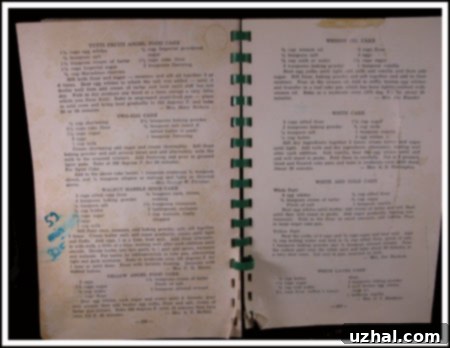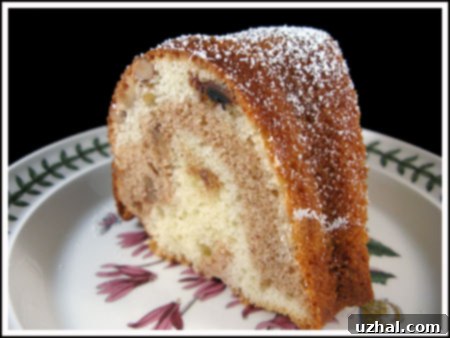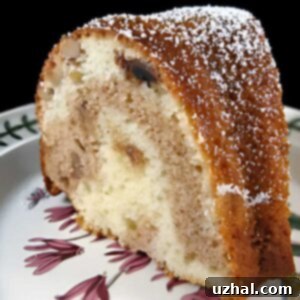Classic Walnut Marble Spice Bundt Cake: A Timeless Recipe from the Methodist Cookbook
Every now and then, the best culinary adventures begin with a quiet afternoon, a stack of old cookbooks, and a willingness to be inspired. On one such day, I found myself captivated by a particular gem: a recipe for a Walnut Marble Spice Cake tucked away in The Methodist Cookbook from St. John’s Methodist in Richmond, Texas. What makes these vintage community cookbooks truly special is their commitment to “from-scratch” baking, often without the precise measurements we’ve grown accustomed to today. Imagine instructions like “add enough flour to reach cookie dough consistency” or “bake in a moderate oven” without a specific temperature. It’s a delightful blend of tradition and intuition that beckons the modern baker to connect with culinary history.

The Enduring Allure of Vintage Recipes
There’s a unique charm in baking from an old cookbook. These aren’t just collections of recipes; they’re culinary time capsules, offering glimpses into kitchens of generations past. Community cookbooks, like this Methodist one, are particularly rich in history, often featuring handwritten notes, beloved family recipes, and the names of the individuals who contributed them. They reflect a time when baking was a fundamental part of home life, relying on basic ingredients and fundamental techniques. The recipes are often robust, comforting, and unfussy, designed to feed families and bring joy with honest, wholesome flavors. While modern baking often emphasizes scientific precision, these older recipes invite a more intuitive, sensory approach – a beautiful dance between tradition and taste.
Don’t Skip the Sift: The Secret to a Perfect Crumb
Perhaps what initially drew me to Mrs. C.D. Myers’ Walnut Marble Spice Cake recipe was its refreshing clarity in a book of charmingly vague instructions. She not only specified an oven temperature of 350°F but also provided clear directions, including the crucial step of sifting the flour multiple times. And what a difference it made! The resulting cake boasted a wonderfully tight, tender crumb, a texture that is truly a testament to following precise instructions and understanding the science of baking.
Sifting flour, especially cake flour, serves several vital purposes. Firstly, it aerates the flour, breaking up any lumps and ensuring it’s light and evenly distributed. This aeration prevents over-mixing and contributes to a delicate, tender texture in the final cake. Secondly, when you sift the flour with baking powder and whisk in the salt, it ensures these leavening agents and seasonings are uniformly distributed throughout the dry ingredients. This leads to an even rise and consistent flavor in every bite. Many modern recipes skip multiple sifts, but this vintage method truly elevates the cake’s texture, making it remarkably soft and fine-grained.
Another crucial element in achieving this cake’s fantastic texture was my decision to use cake flour and weigh it accurately. Cake flour, with its lower protein content, creates a more tender and delicate crumb compared to all-purpose flour. Weighing ingredients, particularly flour, is far more accurate than measuring by volume. A cup of flour can vary significantly in weight depending on how packed it is. By weighing the sifted cake flour, I ensured the precise ratio of ingredients, leading to a consistently perfect outcome. This attention to detail, a blend of Mrs. Myers’ wisdom and modern baking precision, truly made this cake a standout.

Tracing the Origins: A Culinary Detective Story
The exceptional quality of this Walnut Marble Spice Cake sparked my curiosity, prompting me to delve into the vast world of the internet to uncover its potential origins or similar recipes. The closest relative I found was a recipe dubbed “Marble Spice Picnic Cake.” This particular recipe bore a striking resemblance to my Methodist version, though it was scaled down and typically baked in a different size pan. It suggests a popular lineage for this type of spice cake, one that was likely enjoyed at community gatherings and outdoor events – perfect for sharing and easy to transport.
Another intriguing clue emerged from the renowned baking expert, Nick Malgieri. He recounted finding his own marble spice Bundt cake recipe in a vintage cake flour booklet dating back to the 1930s. While Malgieri made significant adjustments to his version, transforming it into something distinct, his discovery strongly hints at a widespread circulation of a foundational marble spice cake recipe during that era. It’s highly plausible that the original recipe from that old cake flour booklet could be the very one that inspired Mrs. C.D. Myers’ contribution to The Methodist Cookbook, or at least a close variation. This connection underscores the timeless appeal of this flavor combination and technique, suggesting it has been cherished and passed down through generations of home bakers.
The enduring popularity of spice cakes during the early to mid-20th century makes perfect sense. Spices were readily available, relatively inexpensive, and offered a wonderful way to add warmth and complexity to baked goods, especially when other more luxurious ingredients might have been scarce. The marbling technique adds an element of visual appeal and textural contrast, making a simple spice cake feel extra special, suitable for everything from a family dessert to a church potluck.
Mastering the Walnut Marble Spice Cake: Essential Baking Tips
This Walnut Marble Spice Cake is a true delight, but like all great baking, it benefits from a few key considerations to ensure perfection every time. Paying attention to these details will elevate your cake from good to truly extraordinary:
- Flour Measurement is Key: As highlighted earlier, accurate flour measurement is paramount. Three cups of sifted cake flour weighs significantly less than three cups of unsifted all-purpose flour. For best results and consistency, I highly recommend using a kitchen scale. Weigh out 285 grams of sifted cake flour. If you must use all-purpose flour and are measuring by volume, aim for about 2 ⅓ cups, and make sure to fluff it up before lightly spooning it into your measuring cups and leveling off. Remember, cake flour’s lower protein content is crucial for that tender crumb.
- Butter and Salt Balance: The recipe calls for salted butter. If you prefer or only have unsalted butter on hand, increase the salt in the recipe to 1 teaspoon. This adjustment ensures the flavors are properly balanced and prevents the cake from tasting bland. Always use softened butter, not melted, for proper creaming with sugar.
- Whole Milk for Richness: For the best flavor and moistness, use whole milk. Its higher fat content contributes to a richer, more tender cake. While skim or low-fat milk might work, they won’t yield the same depth of flavor or luxurious texture.
- Room Temperature Ingredients: This is a non-negotiable tip for almost all baking, and especially for cakes. Ensure your butter, eggs, and milk are all at room temperature. Room temperature ingredients emulsify much better, meaning they combine smoothly to create a stable batter. This results in a lighter, more evenly textured cake. If your ingredients are cold, the batter can curdle, leading to a denser or drier cake.
- Bundt Pan Preparation: A well-prepared Bundt pan is essential for a clean release. Thoroughly grease your 10-inch Bundt pan with butter or baking spray, then lightly flour it, tapping out any excess. If using a silicone Bundt pan, a light coating of oil should suffice, as silicone is naturally non-stick.
- Creaming Butter and Sugar: Beat the softened butter and granulated sugar for a full 5 minutes until the mixture is light, fluffy, and pale in color. This process incorporates air into the batter, which is vital for the cake’s rise and tender texture.
- Adding Eggs Gradually: Add eggs one by one, beating for at least 30 seconds after each addition. This allows each egg to fully incorporate into the butter-sugar mixture, creating a stable emulsion.
- Alternating Wet and Dry: When adding the flour mixture and milk, alternate them in three parts, starting and ending with the flour. This method helps to prevent overmixing, which can develop the gluten in the flour too much and result in a tough cake. Beat on medium-low speed just until smooth.
- The Marbling Technique: After dividing the batter and mixing the spices, molasses, and nuts into one half, gently layer the two batters in the Bundt pan. You can swirl them lightly with a knife or skewer to create the marble effect, but avoid overmixing.
- Cooling Process: Allow the cake to cool in the pan for 10-15 minutes before inverting it onto a wire rack. This cooling period allows the cake to firm up slightly, making it less likely to break when unmolded.
The Flavor Profile and Serving Suggestions
This Walnut Marble Spice Cake is a symphony of comforting flavors. The spices—cinnamon, cloves, and nutmeg—create a warm, aromatic base, reminiscent of molasses cookies or a classic gingerbread, yet with the tender crumb of a delicate Bundt cake. The molasses adds a deep, earthy sweetness and a beautiful richness to the marbled portion, contrasting perfectly with the lighter, vanilla-infused batter. Finely chopped walnuts provide a delightful textural crunch and a nutty depth that complements the spices wonderfully.
It’s a cake that truly shines on its own, perfect with a simple dusting of powdered sugar. However, it also pairs beautifully with a dollop of freshly whipped cream, a scoop of vanilla bean ice cream, or even a light cream cheese glaze if you desire a bit more sweetness and tang. Serve it alongside a hot cup of coffee or a comforting mug of tea for a perfect afternoon treat or a delightful dessert after any meal. This cake is not overly sweet, allowing the complex spice notes to truly sing, making it a sophisticated yet comforting choice for any occasion.
- Buttermilk Marble Cake Baked in a 9×13 inch Pan
- Marbled Peanut Butter Brownies
- Marbled White Chocolate Cheesecake
- Frosted Fudge Brownies
- Marbled Cream Cheese Brownies
Recipe

Walnut Marble Spice Cake
Anna
Pin Recipe
Ingredients
- 3 cups sifted cake flour (285 grams, for that perfect tender crumb)
- 4 teaspoons baking powder
- ½ teaspoon salt (use 1 tsp if using unsalted butter)
- 1 ½ sticks salted butter, softened (170 grams, at room temperature)
- 1 ½ cups granulated sugar (300 grams)
- 3 large eggs (at room temperature)
- 1 cup whole milk (230 grams, at room temperature)
- ½ teaspoon vanilla extract
- ¾ teaspoon each – ground cloves & ground nutmeg
- 1 ½ teaspoon ground cinnamon
- 3 tablespoons molasses (60 grams)
- 1 cup walnuts finely chopped
Instructions
-
Preheat your oven to 350°F (175°C). Prepare a 10-inch Bundt pan by thoroughly greasing and flouring it. For silicone pans, a light coating of oil is usually sufficient for easy release.
-
If using a kitchen scale, weigh out 285 grams of cake flour. If measuring by volume, ensure you sift the flour twice to aerate it, then carefully spoon it into measuring cups and level without packing. After sifting the flour, sift it again with the baking powder, and then whisk in the salt until well combined. This ensures even distribution and a tender crumb.
-
In a large mixing bowl, beat the softened butter and granulated sugar together for approximately 5 minutes. Continue beating until the mixture is exceptionally light, fluffy, and smooth. Stop to scrape down the sides of the bowl as needed. Add the large eggs one by one, beating for at least 30 seconds after each addition to ensure thorough incorporation.
-
In a separate small bowl, mix together the whole milk and vanilla extract. Gradually add the sifted flour mixture and the milk mixture to the butter and egg batter, alternating in 3 parts. Begin and end with the flour mixture. Beat on medium-low speed just until the batter is smooth and no streaks of flour remain, being careful not to overmix.
-
Carefully pour about half of the batter (approximately 3 cups) into a second bowl. To this second bowl, stir in the ground cloves, ground nutmeg, ground cinnamon, molasses, and finely chopped walnuts until evenly distributed.
-
Begin layering the two batters into your prepared Bundt pan, alternating between spoonfuls of the plain batter and the spiced walnut batter. You can gently swirl the batters with a knife or skewer once they are all in the pan to create a beautiful marble effect, but avoid overmixing the two layers.
-
Bake the cake on the center rack of your preheated oven for approximately 55 minutes, or until a wooden skewer or toothpick inserted into the thickest part of the cake comes out clean. Let the cake cool in the Bundt pan for 10-15 minutes before carefully inverting it onto a wire rack to cool completely.
Final Thoughts on This Vintage Gem
Baking this Walnut Marble Spice Cake from The Methodist Cookbook was more than just following a recipe; it was a journey through time, a connection to the simple yet profound joys of home baking from a bygone era. The satisfaction of transforming basic ingredients into such a beautifully textured and richly flavored cake is immense. It’s a reminder that sometimes, the best recipes are the ones that have stood the test of time, proving their worth with every delicious bite.
Whether you’re a seasoned baker looking for a new challenge or simply someone who appreciates the comforting embrace of a classic spice cake, this recipe is well worth the effort. Embrace the careful steps, particularly the sifting and precise measurement of flour, and you’ll be rewarded with a cake that truly captures the essence of homemade goodness. We hope you enjoy making and sharing this timeless dessert as much as we do!
